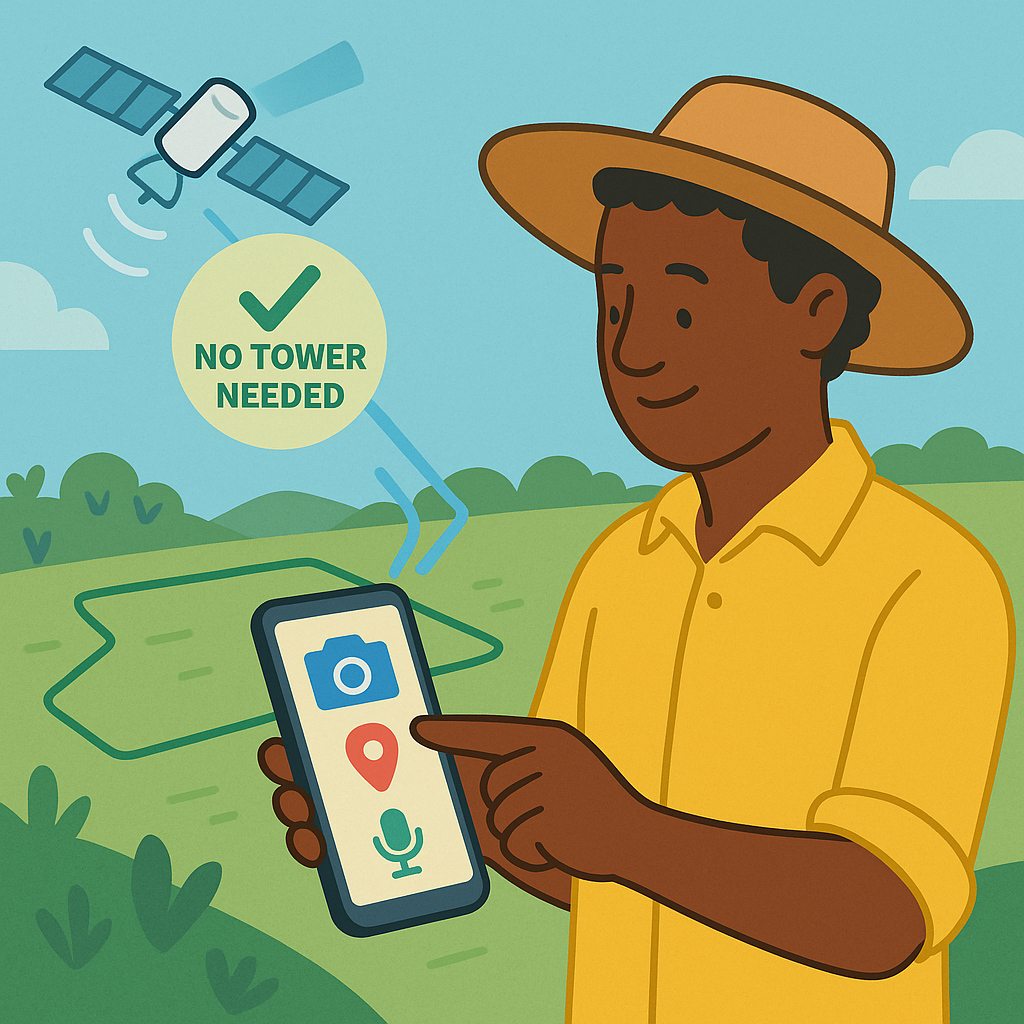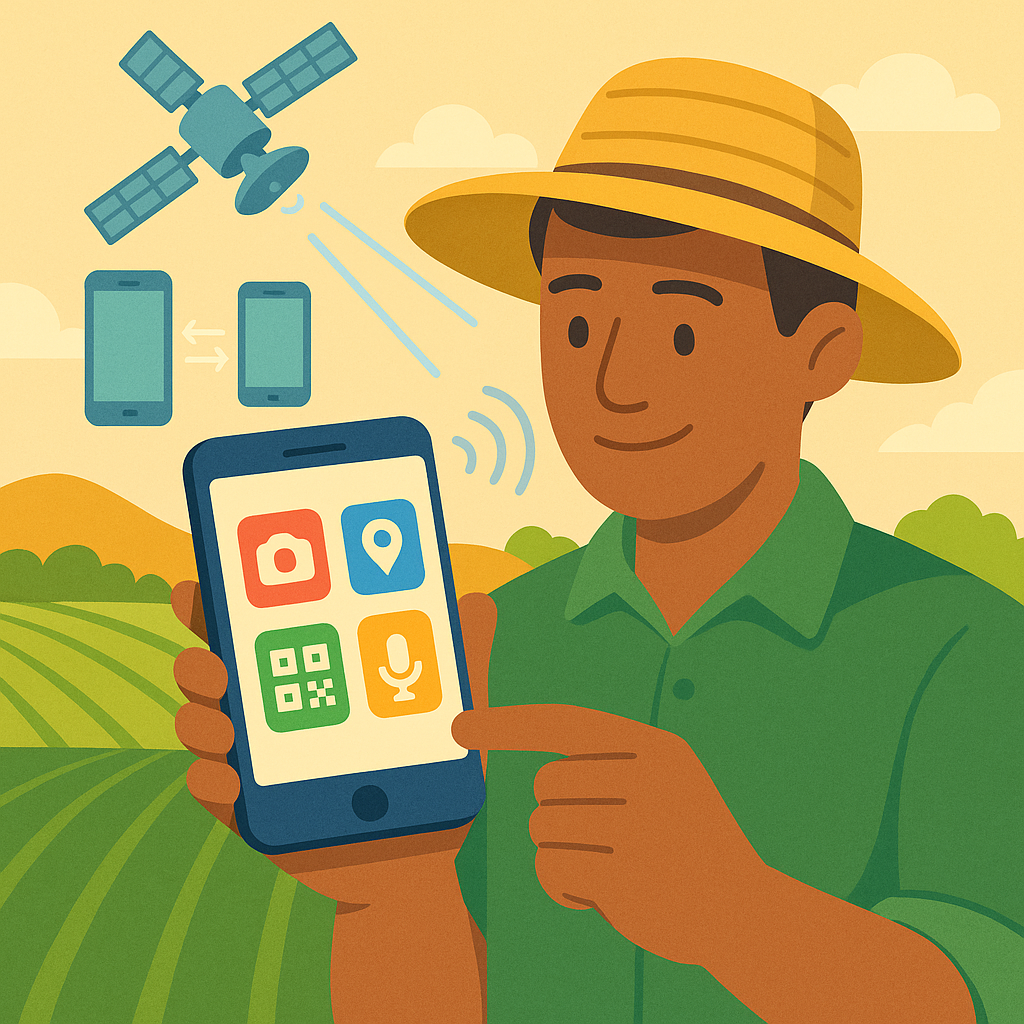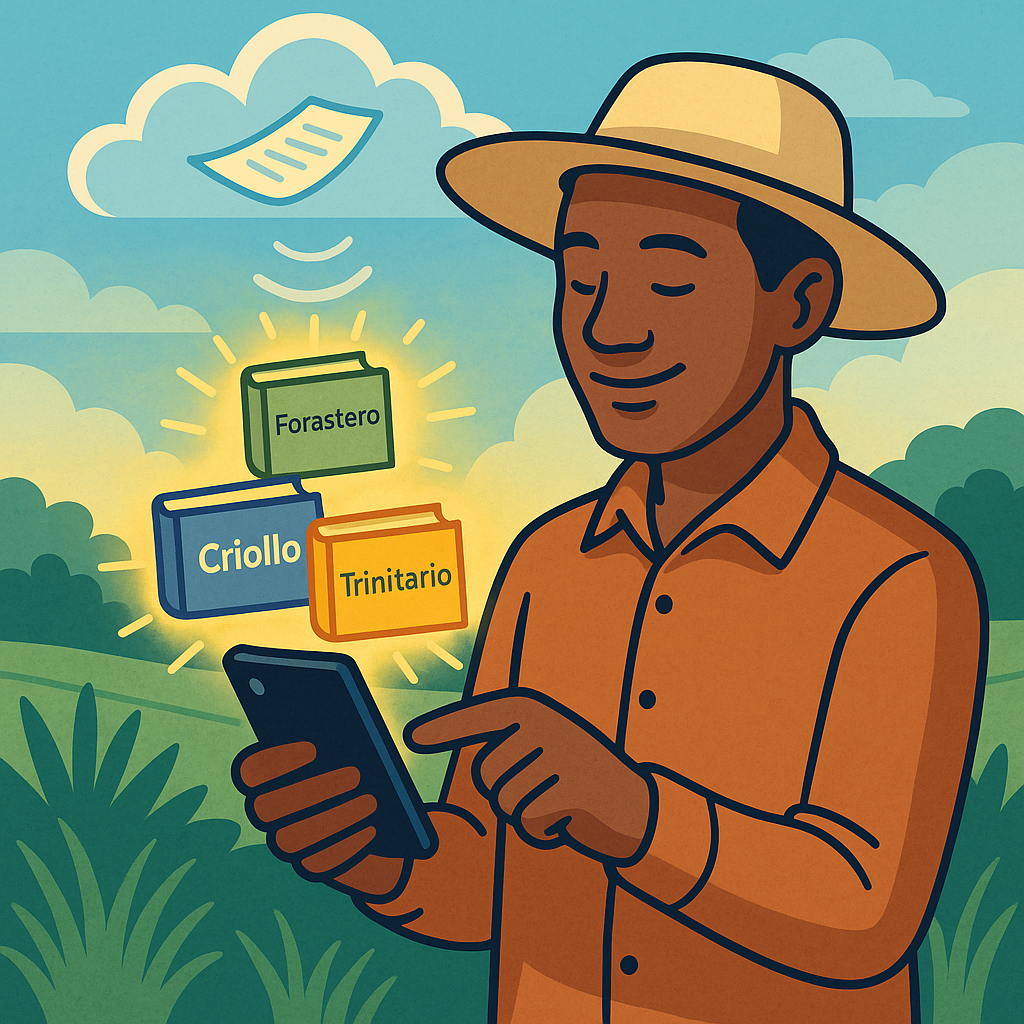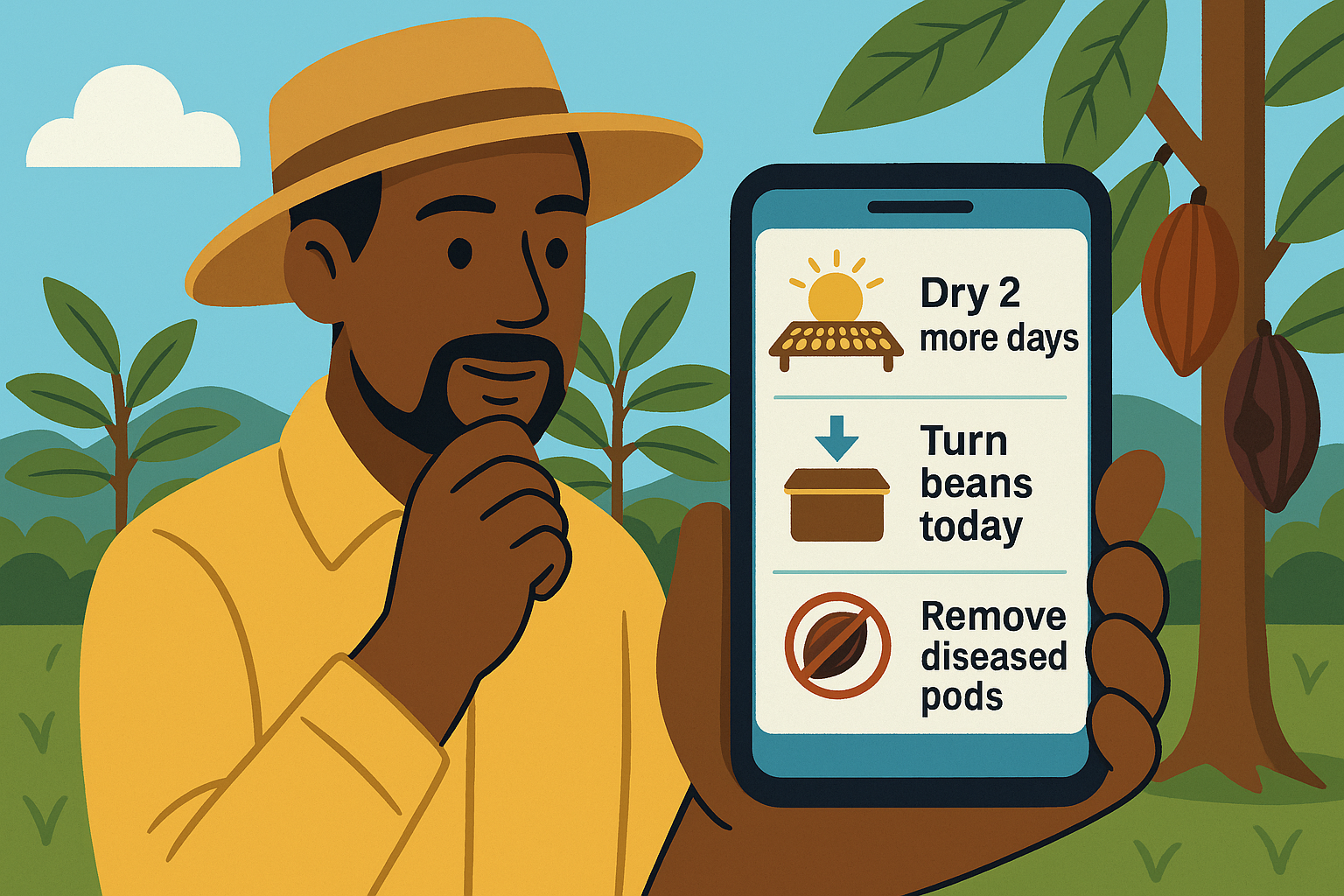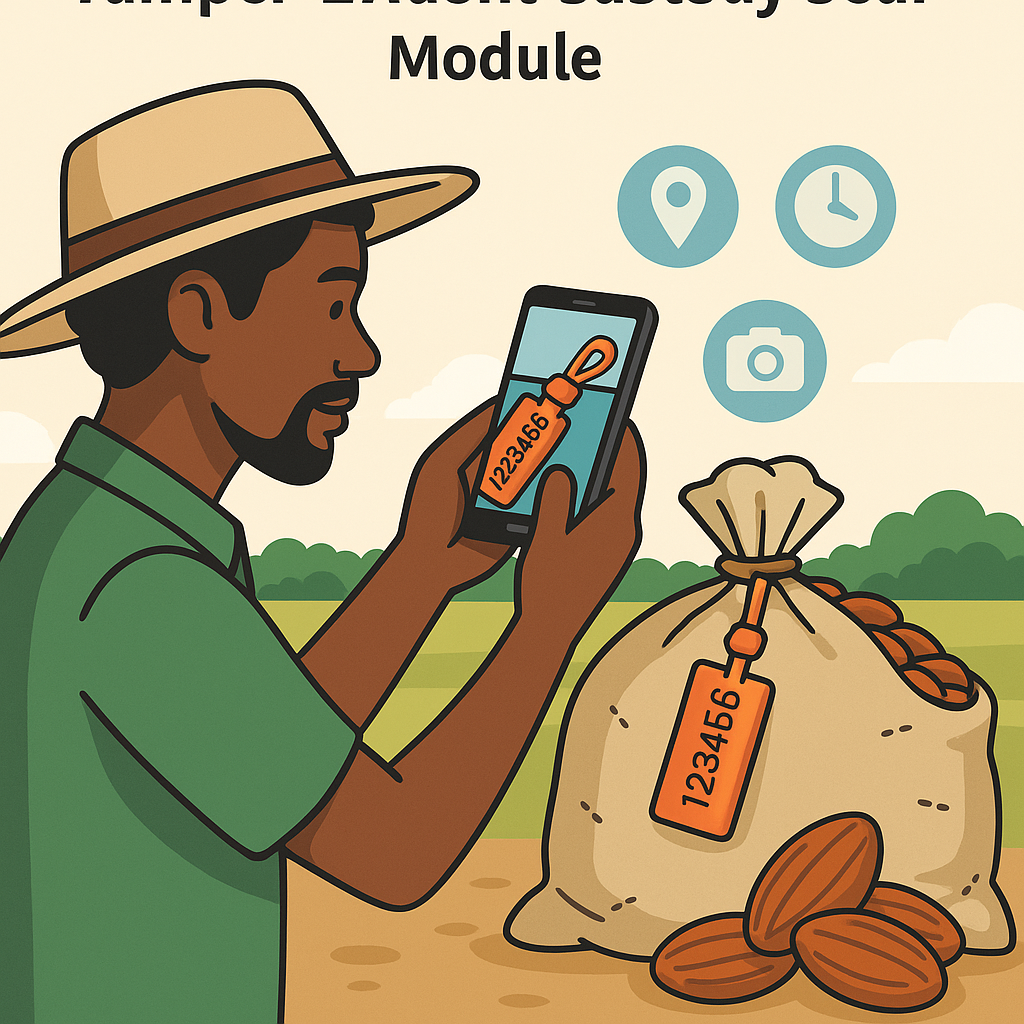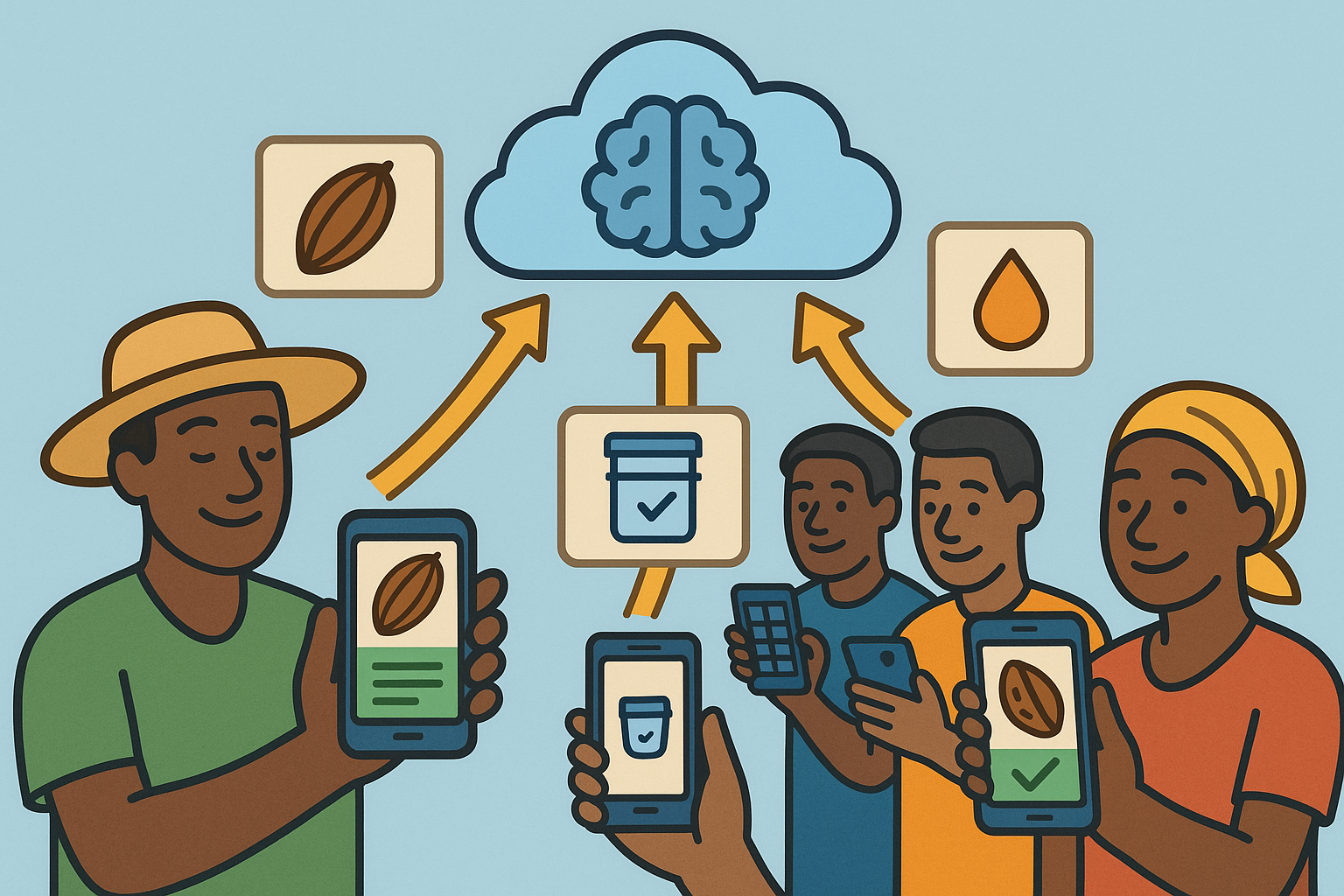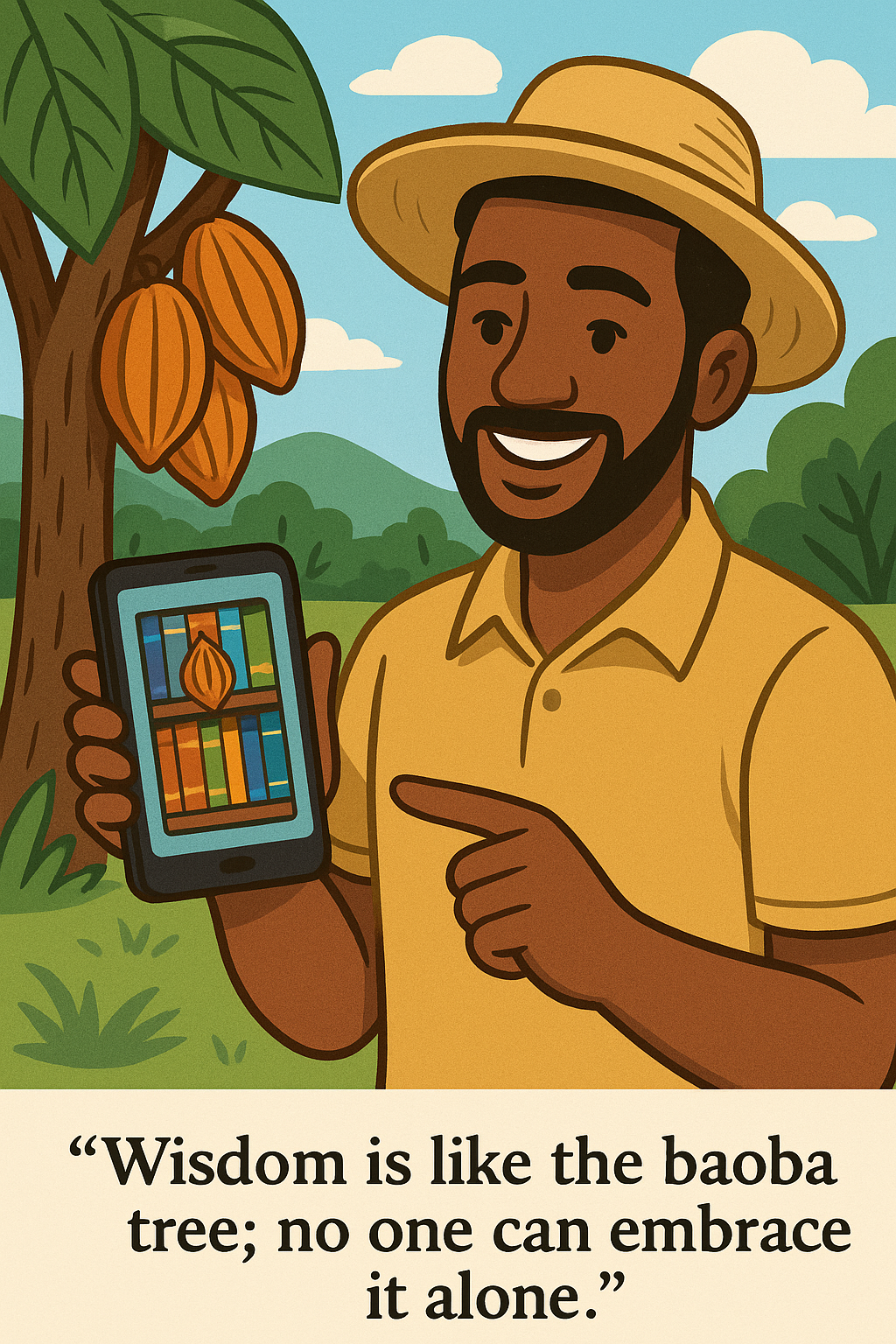iVerify
by North Star Group
Traceability and Quality Control System
Executive Summary
Patent Pending: The iVerify system and methodologies described herein are protected under U.S. Provisional Patent Application No. 63/859,920, filed August 8, 2025. The integrated field-to-ledger verification processes, AI-powered Sentinel Tower child labor monitoring, blockchain custody records, and market enablement technologies disclosed in this presentation are subject to intellectual property protection.
The Problem: A Farmer's Story
Imagine a farmer growing cocoa beans in Ghana. She produces high-quality cocoa that could command premium prices in European markets, but she has no way to prove where it came from, how it was grown, or that it meets certification standards. Because her cocoa is not traceable, both she and her country fail to capture the full value of their work. This lack of certification starves the economy, keeping billions of dollars of value locked away from smallholder producers.
The Solution: "Always On" Satellites
The GPS satellites are always running, everywhere. Most Android phones—including the common, low-cost models like Tecno, Infinix, and Itel already prevalent across developing regions—have GPS capability precise enough to map a farm. This works without internet or cell service. The farmer can use her existing phone to create verifiable, GPS-located records of her production, establishing the traceability that unlocks premium markets.
The Technology: Simple, Secure Ledger
iVerify stores this GPS and production data in a secure, blockchain-style ledger that creates an unchangeable record. When the farmer attaches a unique, numbered tag to each unit of cocoa and takes a photo, she creates definitive proof of origin and compliance. The critical advantage: this data is owned by the national partner—typically the government—ensuring that value and control remain with local institutions.

The Lost Revenue Opportunity from Lack of Certification
Analysis shows over $180 billion in annual revenue is lost because the vast majority of agricultural and mineral products from developing regions are uncertified and cannot access premium markets.
The Business Model: Making Money by Doing Good
We like to make money by doing good at the same time. iVerify generates revenue by enabling smallholder producers to access premium markets while building local capacity and ownership. The platform provides the verifiable documentation needed to meet EUDR and conflict mineral regulations, turning compliance requirements into economic opportunities for smallholder producers and their countries.
The Problem
The Traceability Crisis: Why African Producers Are Locked Out
smallholder producers face an immediate crisis: new international regulations demand precise traceability, but the technology and systems to provide this proof remain inaccessible to millions of smallholder farmers and miners.
1. Regulatory Requirements Are Now Mandatory
Major markets have moved beyond voluntary certification to mandatory traceability requirements.
- The EU Deforestation Regulation (EUDR) requires full GPS traceability for all cocoa, coffee, and palm oil imports by December 2025.
- Conflict mineral regulations demand documented proof of mine origin for all minerals entering global supply chains.
- Producers without this proof will be banned from premium markets, losing access to billions in revenue.
2. The Technology Gap
Current traceability solutions are designed for developed markets, not developing market realities.
- With only 15% rural internet access in developing regions, web-based systems fail in the field.
- Existing solutions require expensive equipment and high literacy levels that exclude smallholder producers.
- Most systems store data externally, creating dependency on foreign platforms rather than building local capacity.
3. The Innovation Opportunity
The components for a solution already exist - they just need to be integrated effectively.
- GPS satellites run everywhere, always - most Android phones can already map a farm.
- Low-cost Android phones (Tecno, Infinix, Itel) are already prevalent across developing regions.
- Simple, proven technologies exist for offline data collection and secure storage.
- What's missing is integration that works for smallholder producers and keeps data ownership local.
The path forward requires producer-centered solutions.
iVerify integrates proven technologies in new ways, designed specifically for smallholder producers and owned by local partners. The components are field-tested - the innovation is in making them work together seamlessly.
Read the Full White PaperThe Solution
EU-Compliant Verification at Zero Cost to Producers
iVerify solves the core problem: farmers and miners need EU-compliant traceability, but existing solutions are too expensive and complicated. Our approach is different—accurate, compliant, and free to use.
Working Technology, Not Just Concepts

↗ Click to view live, interactive report
This demonstrates the GPS mapping, photo integration, and professional reporting that powers iVerify

The complete process: Walk your property, tag your product, meet EU requirements
Works Anywhere, For Anyone
No internet required: GPS satellites work everywhere—remote farms, deep mines, anywhere on Earth
No literacy required: Just buttons to push, nothing to read
No special equipment: Uses Android phones farmers already own
This removes every barrier. No connectivity requirements, no education requirements, no equipment costs. Anyone can use it immediately.
Three Simple Steps, Zero Cost
Step 1: Walk around your property (GPS works offline)
Step 2: Tag and photograph your produce (all offline)
Step 3: Upload later when you find internet—you now meet EU requirements
Zero cost to producers. Premium market access creates enough value to fund the entire system without charging farmers or miners.
The Business Model: Free to Use, Funded by Value Created
When millions of smallholder producers can suddenly access premium markets, the economic value is enormous. That value funds the platform—no cost to farmers, no barriers to adoption, maximum market penetration. Everyone wins: producers get market access, buyers get compliant supply chains, and the platform scales globally.
Workflow: Agriculture
iVerify Agricultural Process
From Farm to Market - Technology That Works Offline
Complete Offline-First Agricultural Verification
Click any panel above to explore detailed implementation guides, specifications, and business analysis stored in our Memory System.
A Field-to-Ledger Process for Farmers
The platform's workflow is engineered to be offline-first and accessible to users with any level of literacy. It requires no specialized hardware beyond the farmer's own smartphone.
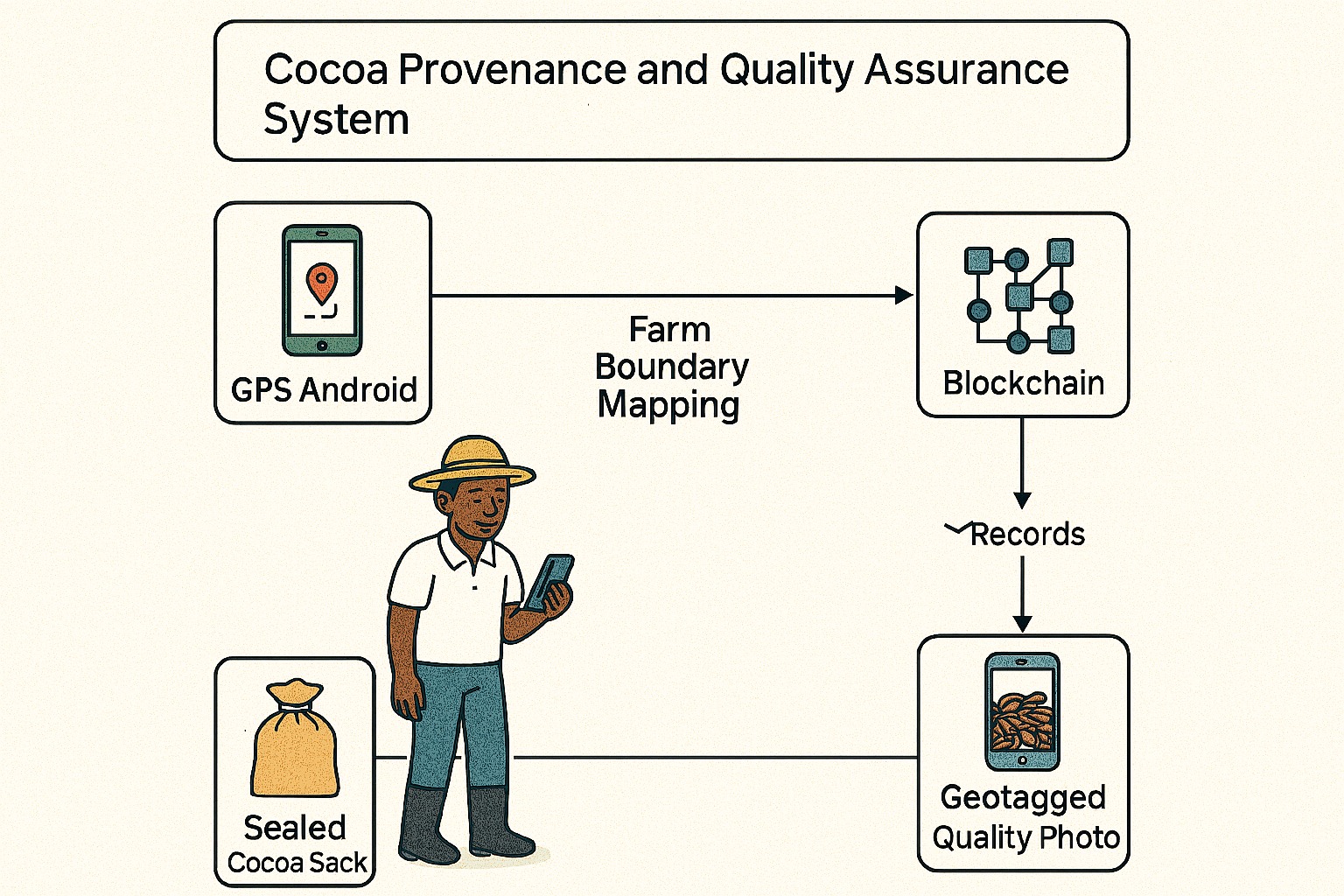
Complete agricultural workflow: Farm registration, product tagging, and verification process
Part 1: One-Time Farm Registration
-
Step 1: Installation & Map Caching (Online)
The farmer downloads the iVerify app from the Play Store while in an area with internet. The app automatically downloads and caches map tiles for their specific region.
-
Step 2: Map the Farm (Offline)
Back at their farm with no internet connection, the farmer opens the app and walks the perimeter. The phone's native GPS creates a precise digital boundary, which is saved locally.
-
Step 3: Identity Verification (Offline)
The farmer completes a profile in the app by taking a selfie and capturing photos of identity or land-claim paperwork, linking a person to a specific GPS-defined property.
-
Step 4: First Synchronization (Online)
The next time the farmer has internet access, they press a single "UPLOAD" button. The app securely uploads the map and identity data, creating their foundational record.
Part 2: Ongoing Harvest Verification
-
Step 5: Secure the Product (Offline)
The farmer locks a sack of produce with a uniquely numbered security tag and uses the iVerify app to photograph it. The photo is automatically geotagged, creating an unchangeable link between that specific product, a time, and a location on their registered farm.
-
Step 6: Premium Verification (Multi-Pesticide Testing) (Offline)
For access to the highest-value markets, the platform supports on-site testing for 6 major pesticide classes. Using simple, field-ready reagent kits, the farmer documents the results with a color-calibrated DNG photo, providing verifiable proof of a premium, chemical-safe product.
-
Step 7: Final Upload & Verification (Online)
During the next sync, all new verification data is uploaded and permanently linked to the product's record. Anyone with the number from the tag can now verify the product's origin and quality.
Workflow: Mining
A Field-to-Ledger Process for Miners
The same offline-first application empowers artisanal miners with a simple, secure method for establishing provenance and creating a tamper-proof chain of custody for high-value minerals.
Part 1: One-Time Claim Registration
-
Step 1: Installation & Map Caching (Online)
A miner or cooperative manager downloads the iVerify app and registers while in an area with internet access. The application caches high-resolution map tiles for their claim area.
-
Step 2: Map the Claim (Offline)
On-site, the user walks the perimeter of their mining claim. The phone's GPS creates a precise digital boundary, defining the specific geographic origin of all minerals extracted from that area.
-
Step 3: Identity Verification (Offline)
The user creates a profile by taking a selfie and capturing photos of their identity and any official claim or license paperwork. This establishes a verifiable link between the individual, their identity, and the GPS-defined claim.
-
Step 4: First Synchronization (Online)
During the next internet connection, a single "UPLOAD" button press securely transmits the claim boundary and identity data, creating the foundational record for all future production.
Part 2: Ongoing Production Verification
-
Step 5: Secure the Product (Offline)
A miner secures a bag of ore or a container of high-value minerals (e.g., gold, gemstones) with a uniquely numbered security tag. Using the app, they take a high-fidelity RAW/DNG photograph that clearly captures the secured container and the unique tag number. The photo is automatically geotagged, creating an unchangeable link between that specific batch of product, a time, and a location within their registered claim. This serves as a powerful tool against theft and substitution.
-
Step 6: Continuous Labor Verification (Automated)
For premium ethical certification, the site is monitored by the iVerify Sentinel Tower. The tower's cameras stream video via a commercial satellite service to an off-premises AI for analysis. The AI continuously monitors for the presence of children and verifies adherence to PPE standards, creating a constant stream of compliance data linked to the registered claim.
-
Step 7: Final Upload & Verification (Online)
All new production and verification data is uploaded during the next sync and permanently linked to the product's record. Buyers and regulators can use the tag number to instantly verify the product's origin and the ethical conditions under which it was produced.
Verification: The Sentinel Tower
System Architecture: The iVerify Sentinel Tower
To address the verification challenges of the Artisanal and Small-Scale Mining (ASM) sector, the platform can utilize a specialized, autonomous surveillance unit: The Sentinel Tower. It is engineered for resilience, low maintenance, and operational integrity in remote environments based on three core principles:

The iVerify Sentinel Tower: Autonomous surveillance for continuous mining verification
1. Physical Hardening
The tower is designed to withstand both extreme weather and deliberate tampering.
- Ballistic-Grade Steel: The core electronics enclosure is constructed from AR500 steel to protect against damage from small arms fire.
- Hardened Optics: Cameras are housed in ballistic-grade polycarbonate domes to withstand significant impact.
- Robust Construction: The mast is built from heavy-gauge galvanized steel and secured to a concrete footing to survive high winds.
2. Multi-Layered Redundancy
The system is designed to reduce single points of failure and maximize operational uptime.
- Camera Redundancy: An array of at least three cameras with overlapping fields of view ensures complete coverage even if one camera fails.
- Maintenance Redundancy: An integrated, secure locker at the base contains a full set of "hot-swappable" spares (cameras, processing unit), reducing potential downtime from weeks to hours.
3. Power and Connectivity Autonomy
The Sentinel Tower is designed to operate completely off-grid, independent of local infrastructure.
- Power System: An oversized solar panel array charges a high-capacity lithium battery bank, designed to operate for multiple consecutive days with no sunlight.
- Connectivity: A Starlink satellite terminal provides the primary data uplink, with a 4G/5G cellular modem as a failover backup to ensure data transmission.
4. AI-Assisted Verification
The Sentinel Tower streams visual data from the worksite to a secure, off-premises AI for analysis.
- Child Labor Detection: AI models analyze video feeds to detect the presence of children, using facial biometrics and anatomical proportion recognition.
- Compliance Monitoring: The AI can also monitor for other key indicators, such as the use of Personal Protective Equipment (PPE) and entry into restricted zones.
By combining these layers of physical security, redundancy, and intelligent analysis, the Sentinel Tower can provide a continuous, verifiable, and tamper-resistant data stream of worksite conditions, offering a different approach to the point-in-time verification provided by traditional human audits.
The Opportunity
The Market Drivers Behind the $180 Billion Opportunity
The massive revenue gap between certified and uncertified goods is driven by powerful global trends in regulation and consumer demand. iVerify is positioned to help producers cross this gap and capture that value.
The Mining Verification Market
This market is driven by intense public and regulatory scrutiny of child labor and conflict mineral financing. Global brands require verifiable proof that their supply chains are clean, creating the significant price premiums for certified minerals.
The Agricultural Compliance Market
New regulations like the EU's Deforestation Regulation (EUDR) have made farm-level traceability a mandatory requirement for market access. As of December 2025, any producer who cannot provide GPS-based proof of origin will be restricted from the EU market, making certification a necessity, not a choice.
The Premium Pricing Market
Across both sectors, documented premiums exist for verifiably ethical, organic, or compliant products. By providing the on-the-ground proof that is currently missing, iVerify enables producers to qualify for these established higher prices.
The African Ownership Advantage
As an locally-owned and operated platform, iVerify is well-positioned to partner with national governments and producer cooperatives. This model ensures that the value unlocked through certification remains with local producers and contributes to sustainable economic development.
Ownership & Revenue
A Framework for Revenue and Value Sharing
The iVerify business model is built on partnership. The commercial framework is flexible and open for discussion with key partners, whether they are government bodies, private investors, or telecommunications providers.
The core principle is to capture a small fraction of the value the platform creates. This value is realized through:
- Guaranteed Market Access: Meeting regulatory demands like the EUDR.
- Unlocking Premium Prices: Providing the verifiable proof required for ethical and organic premiums.
- Reducing Risk and Theft: Creating an immutable chain of custody for high-value goods.
- Generating Data Insights: Providing national-level data on production and compliance.
Tiered Service Levels for Discussion
To accommodate different needs, a flexible, tiered service model is proposed as a starting point for conversation:
Tier 1: Compliance Foundation
Provides the essential tools for GPS mapping, chain of custody, and regulatory reporting (e.g., EUDR).
Tier 2: Premium Verification
Includes all Tier 1 features plus advanced verification modules, such as on-site pesticide testing for agriculture or the AI-assisted labor monitoring for mining.
Tier 3: Enterprise & National Scale
A customized suite including all verification modules, direct API access for integration into national systems, and advanced data analytics dashboards.
The final pricing structure will be co-developed with partners to ensure it is sustainable, equitable, and maximizes the economic benefit for the producers and nations it serves.
Founder's Role
Management, Governance, and Founder's Role
Locally-Majority Ownership
iVerify will be incorporated and headquartered in developing regions with majority equity ownership held by its local partners. This ensures the platform's governance and economic benefits are centered within the communities it serves.
Founder & Systems Integrator: The North Star Group
The North Star Group, led by founder and technology architect Michael Hoffman, provides the foundational technology platform and strategic integration services for the iVerify project. The team's role is strategic, focused on successful technology transfer and long-term partnership.
Core Technology (Field-Proven)
The foundation of iVerify is a robust, pre-existing mapping and reporting application that has been field-tested. It demonstrates all core capabilities required for traceability, including offline GPS mapping, photo integration, data sync, and multi-format report generation.
 Click to view a live, interactive report.
Click to view a live, interactive report.
Strategic Role & Equity
- The founder's team will act as the Systems Integrator, ensuring the technology is successfully adapted and deployed.
- They will provide ongoing technology transfer and strategic integration expertise.
- The founder's team will not have an active role in the day-to-day operations of iVerify, which will be fully managed by its local leadership.
- For this foundational contribution, the North Star Group expects to retain between 15% and 25% of the total project equity.
The Ask
Next Steps: A Funded Pilot Program
The core technology for the iVerify platform is built, field-proven, and ready for deployment. The immediate next step is to launch a targeted, funded pilot program with a strategic partner to create a real-world case study and validate the operational model.
Pilot Program Objectives
1. Deploy the Core App
Equip a select group of agricultural and mining producers in a target region with the Android application to establish their claims and begin logging chain-of-custody data.
2. Install a Sentinel Tower
Deploy one fully operational Sentinel Tower at a partner mining site to demonstrate the continuous, AI-assisted labor verification system in a live environment.
3. Create the Case Study
Gather 6-12 months of verifiable data on compliance metrics, producer income premiums, and system reliability to present to global buyers and additional national partners.
We Are Seeking a Strategic Partner
We are looking for a foundational partner who shares our vision for an locally-owned, technology-driven verification system. The ideal partner brings strategic alignment, operational support within a target country, and the necessary funding to launch this pilot program.
Let's schedule a meeting to discuss the pilot budget, timeline, and how we can work together to improve ethical sourcing in developing regions.
Political Considerations
Sunshine is best for everyone

Click chart to expand
How iVerify Creates Mutual Transparency
The ultimate buyer is seen by the farmer, and the farmer sees the ultimate buyer. Both sides know the price, and CoCoBod sits in the middle facilitating trust and transparency. Because the revenue has doubled, the pay for everybody has increased.
Nobody wants the government to starve, but nobody wants to starve themselves either.
Ghana's cocoa sector operates in a political environment where informal payments and inefficiencies are common. Roughly 12% of revenues are lost to these "rents," which mid-level officials and local actors rely on to supplement their income. While this practice sustains livelihoods, it weakens national revenues and undermines farmer trust.
At the same time, the government faces pressure from two directions. Farmers demand fairer treatment and visibility into their payments, while international buyers require strict compliance with EU deforestation rules to preserve market access. The leadership understands that billions in export earnings are at risk if the system does not modernize.
Introducing transparency through tools like iVerify disrupts the status quo. Some actors will resist because their informal benefits shrink. But the larger system gains—smuggling decreases, export volumes rise, and price premiums increase—mean the overall pie grows. When revenues nearly double, the state can formalize compensation for officials, preserve political stability, and still leave more money for both leadership and farmers.
In short, the political challenge is real, but the solution is not about punishment. It is about shifting from a fragile, opaque system to a stronger, transparent one where every level—leaders, administrators, and farmers—benefits from higher national income.

Click chart to expand
Key Insight: Transparency nearly doubles total revenues. While informal "rents" (~12%) shrink, the larger pie allows leaders to retain discretion, farmers to see fair returns, and government to capture more export value. Sunlight reduces leakage and creates a cleaner, more sustainable system for everyone.
Technical Wiring
If greater precision is required: RTK Mapping Kit: Wiring & Assembly Documentation
System Wiring Architecture
The RTK mapping system requires precise wiring between GNSS modules, computing units, radio telemetry, and power systems. This documentation provides step-by-step assembly instructions ensuring reliable field operation.
📍 Base Station Wiring Diagram
+12V MOTORCYCLE POWER
│
┌────▼────┐
│ DC-DC │ (12V → 5V, 3A)
│ BUCK │
└────┬────┘
│ +5V
┌────┼────┬────────────┐
│ │ │ │
┌───▼──┐ ┌─▼─┐ ┌──▼──────┐ ┌▼───┐
│ PI4B │ │ZED│ │ RFD900X │ │LED │
│ │ │F9P│ │ RADIO │ │ │
└───┬──┘ └─┬─┘ └──┬──────┘ └────┘
│ UART │ SMA │ SMA
│14/15 │ │ │ │
└──────┼──┘ └──┼──────
│ │
GNSS 900MHz
ANTENNA ANTENNA
Base Station GPIO Connections
| Component | Pi GPIO Pin | Wire Color | Function |
|---|---|---|---|
| ZED-F9P TX | GPIO15 (Pin 10) | Orange | GNSS data to Pi |
| ZED-F9P RX | GPIO14 (Pin 8) | Yellow | Pi commands to GNSS |
| RFD900X TX | GPIO17 (Pin 11) | Green | Radio data to Pi |
| RFD900X RX | GPIO16 (Pin 36) | Blue | Pi corrections to radio |
| Status LED | GPIO18 (Pin 12) | White | RTK fix indicator |
🎒 Rover Unit Wiring Diagram
USB POWER BANK (20Ah, 5V)
│ +5V USB
┌────┼────┬────┬────┬────┐
│ │ │ │ │ │
┌───▼─┐ ┌─▼─┐ ┌─▼─┐ ┌─▼──┐ ┌▼──┐
│PI0W │ │ZED│ │RFD│ │OLED│ │RTC│
│ │ │F9P│ │900│ │ │ │ │
└─┬─┬─┘ └─┬─┘ └─┬─┘ └─┬──┘ └┬──┘
│ │ I2C │ SMA │ SMA │ I2C │ I2C
│ │2/3 │ │ │ │ │2/3 │2/3
│ └─────┼──┘ └──┼──┴─────┘
│ │ │
│ GNSS 900MHz
│ ANTENNA ANTENNA
│
┌─▼──┐ ┌──────┐
│BTN │ │BUZZER│
│21 │ │ 20 │
└────┘ └──────┘
Rover Unit GPIO Connections
| Component | Pi Zero Pin | Wire Color | Function |
|---|---|---|---|
| OLED SDA | GPIO2 (Pin 3) | Blue | I2C data line |
| OLED SCL | GPIO3 (Pin 5) | Yellow | I2C clock line |
| ZED-F9P TX | GPIO15 (Pin 10) | Orange | GNSS data to Pi |
| ZED-F9P RX | GPIO14 (Pin 8) | Yellow | Pi commands to GNSS |
| RFD900X TX | GPIO17 (Pin 11) | Green | Radio data to Pi |
| RFD900X RX | GPIO16 (Pin 36) | Purple | Pi to radio |
| DS3231 RTC | GPIO2/3 (I2C) | Blue/Yellow | Real-time clock |
| Button Input | GPIO21 (Pin 40) | White | Waypoint logging |
| Buzzer Output | GPIO20 (Pin 38) | Red | Audio feedback |
Step-by-Step Assembly Instructions
Phase 1: Component Preparation
- Inventory Check: Verify all components against parts list
- Static Protection: Use anti-static wrist strap when handling modules
- Workspace Setup: Clean, well-lit area with adequate ventilation
- Tool Preparation: Soldering iron, multimeter, wire strippers ready
Phase 2: Power System Assembly
- Base Station Power:
- Install DC-DC buck converter in base enclosure
- Connect 12V input with 5A fuse protection
- Verify 5V output with multimeter before proceeding
- Rover Power:
- Test power bank output voltage (should be 5.0V ±0.1V)
- Install power switch in rover enclosure
- Create power distribution harness for all components
Phase 3: Data Line Connections
- UART Connections:
- Use 22AWG stranded wire for all data connections
- Solder connections with proper strain relief
- Test continuity with multimeter before power-on
- I2C Bus (Rover Only):
- Connect OLED and RTC to shared I2C bus
- Install 4.7kΩ pull-up resistors on SDA/SCL lines
- Keep I2C wires under 30cm to prevent signal degradation
Phase 4: RF System Integration
- Antenna Placement:
- GNSS and radio antennas minimum 15cm separation
- Use quality SMA connectors with proper torque (8 in-lbs)
- Route antenna cables away from power lines
- Radio Configuration:
- Pre-configure RFD900X radios with matching parameters
- Set base to broadcast mode, rover to receive mode
- Test radio link before final assembly
System Testing & Validation
Pre-Power Testing
- ✓ Continuity test all data connections
- ✓ Verify power rail voltages (5V ±5%)
- ✓ Check for short circuits between power and ground
- ✓ Confirm antenna connections are secure
- ✓ Verify all components are properly mounted
Initial Power-On Testing
- ✓ Power base station first, monitor current draw
- ✓ Verify Pi boot sequence and network connectivity
- ✓ Confirm GNSS module communication via UART
- ✓ Test radio transmission between units
- ✓ Verify OLED display functionality (rover)
RTK System Validation
- ✓ Achieve GNSS satellite lock on both units
- ✓ Establish RTK base station mode
- ✓ Confirm correction data broadcast
- ✓ Verify rover receives corrections and achieves RTK fix
- ✓ Test positioning accuracy with known reference point
Common Issues & Solutions
Power Issues
Solution: Check 5V power supply, verify SD card integrity
Solution: Check for short circuits, verify component ratings
Communication Issues
Solution: Verify UART connections, check baud rate settings
Solution: Confirm frequency settings, check antenna connections
RTK Issues
Solution: Verify correction data reception, check base station position
Solution: Improve antenna ground plane, reduce multipath interference
Safety & Best Practices
⚡ Electrical Safety
- Always disconnect power before making connections
- Use proper fuse protection on all power inputs
- Verify polarity before connecting power
- Test with multimeter before applying power
🔧 Assembly Safety
- Use anti-static precautions with all electronics
- Proper ventilation when soldering
- Secure all connections with strain relief
- Label all wires for future maintenance
🌧️ Environmental Protection
- Ensure IP65 rating on all enclosures
- Use marine-grade silicone for sealing
- Install desiccant packs to prevent condensation
- Test water resistance before field deployment
Technical Overview

How the Technology Works
What is GPS?
GPS stands for Global Positioning System. It uses satellites in space to tell you exactly where you are on Earth. Your smartphone has GPS built in.
Regular GPS is accurate to about 3-5 meters. That's good enough to find a building, but not good enough to map a farm boundary.
What is RTK GPS?
RTK stands for Real-Time Kinematic. It's a way to make GPS much more accurate. RTK GPS can tell your location within 1-2 centimeters. That's about as thick as your fingernail.
RTK works by using two GPS receivers:
- Base station: Sits in one spot and knows exactly where it is
- Rover: Moves around and gets corrections from the base station
Step 1: Mapping Farm Boundaries
We use RTK GPS to create exact maps of cocoa farms. Here's how it works:
Set Up Base Station
Mount GPS equipment on a motorcycle. Power it from the motorcycle battery.
Walk the Boundaries
A technician walks around the farm edges with a handheld GPS device.
Save the Map
The GPS device records exact coordinates. This creates a digital map of the farm.
Equipment Needed
| Equipment | What It Does | Cost |
|---|---|---|
| RTK GPS Set | Creates accurate farm maps | $400-500 |
| Small Computer | Saves and processes GPS data | $15-20 |
| Power System | Runs equipment from motorcycle | $10-15 |
| Weather Protection | Keeps equipment dry and safe | $25-50 |
Step 2: Documenting Cocoa Sacks
Every sack of cocoa gets photographed with location information. This proves where it came from.
How Sack Documentation Works
- Farmer gets a small GPS device that connects to their phone
- When they fill a sack, they take a photo
- The GPS device automatically adds location and time information
- Each sack gets a unique plastic seal with a number
What the Farmer Needs
GPS Device: Small device that connects to phone ($30-40)
Phone: Basic smartphone with camera
Plastic Seals: About 1 cent each
What Gets Recorded
Location: Exact GPS coordinates
Time: When the photo was taken
Photo: Picture of the sealed sack
Step 3: Testing Cocoa Quality
We can test cocoa quality using a smartphone camera and simple chemicals.
Visual Quality Testing
We take high-quality photos of cocoa beans on a white background. These photos show:
- How well the beans are fermented (color)
- If there's any mold or damage
- How uniform the beans are
- If there are foreign objects mixed in
Pesticide Testing
We can test for pesticides using a simple chemical reaction:
- Apply a small amount of testing chemical to some beans
- If pesticides are present, the chemical changes color
- Take a photo of the color change
- This creates proof that the cocoa is pesticide-free
Keeping Records Safe
All the information gets stored in a secure digital record. This uses technology called blockchain.
Think of blockchain like a notebook that can't be erased or changed. Once information is written in it, everyone can see it, but no one can change it.
What This Means
- Buyers can trust the information is real
- No one can fake or change the records
- Farmers have proof of their good practices
- The system works without internet connection
Easy to Use
The system is designed for people who cannot read or write. It uses:
- Pictures instead of words
- Green buttons for "OK" and red for "stop"
- Simple step-by-step procedures
- Local technicians for setup and training
Important Facts
Average Farm Size: A typical cocoa farm produces 16 sacks per year (1,000 kg total)
No Internet Needed: Everything works offline and syncs later when connection is available
Proven Technology: All components are already used successfully in other farming applications
System Overview
System Overview
Four-Step Traceability Process
Our system provides end-to-end traceability through four integrated steps that build upon each other to create comprehensive quality assurance.
Complete Process Flow
Farm Mapping
RTK GPS surveyor on motorcycle creates precise farm boundary maps, establishing unique digital identity for each farm
Sack Traceability
Farmer uses smartphone app to photograph and geo-tag each cocoa sack, linking harvest to specific farm location
Bean Quality
Visual quality assessment using calibrated photography to document ripeness, color, and physical condition
Pesticide Detection
Field-ready reagent testing with photographic documentation provides chemical residue verification
Technical Integration
RTK GNSS Mapping
High-precision GPS creates sub-meter accurate farm boundaries using base station and rover configuration
Blockchain Recording
All data cryptographically hashed and stored on immutable ledger for buyer verification
Mobile Documentation
Smartphone-based photo capture with GPS coordinates creates geotagged quality records
Sealed Chain of Custody
Tamper-evident seals maintain integrity from farm to export, preventing substitution
Geographic Implementation
The system is designed for deployment across West African cocoa-growing regions, with initial focus on Ghana and Côte d'Ivoire where regulatory pressure for traceability is strongest.
Regional Advantages
- EU deforestation regulations create urgent demand for traceable cocoa
- Existing mobile network infrastructure supports smartphone-based documentation
- Government support for digital agriculture initiatives
- Established cooperative structures facilitate farmer training and adoption
Modular Implementation Strategy
Scalable Deployment
Farmers can start with basic traceability (Steps 1-2) and incrementally add quality verification (Steps 3-4) as buyer premium commitments are secured.
| Implementation Phase | Steps Included | Annual Cost | Required Premium |
|---|---|---|---|
| Basic Traceability | Farm Mapping + Sack Traceability | $152 | $9.50/sack (break-even) |
| Enhanced Quality | All Four Steps | $280 | $17.50/sack (break-even) |
Implementation
How to Make This Happen
Start Small, Then Grow
The best way to implement this system is to start with a small test. If the test works well, we can then expand to help more farmers.
Phase 1: Test the GPS Mapping
First, we test the GPS equipment with a small group of farms. This proves the technology works in Ghana.
What We Would Do
Choose Test Area
Pick 50-100 farms in 2-3 districts that want to participate
Get Equipment
Buy GPS equipment and train 2-3 technicians to use it
Map the Farms
Use GPS to create exact boundary maps for each farm
Check Results
Make sure the maps are accurate and useful
Success Measures for Phase 1
- GPS equipment works reliably in rural Ghana
- Technicians can operate equipment without problems
- Boundary maps are accurate and accepted by farmers
- Process can be repeated for many farms
Phase 2: Add Photo Documentation
Once GPS mapping works, we add the photo system for cocoa sacks.
What Gets Added
Equipment Distribution
Give GPS devices to 20-30 farmers
Help farmers install apps on their phones
Provide plastic seals for cocoa sacks
Training
Show farmers how to take photos
Teach them to attach GPS location
Practice using plastic seals correctly
What We Measure
- How many farmers use the system correctly
- How many sacks get properly documented
- How well the GPS location works
- If buyers accept the documentation
Phase 3: Test Cocoa Quality
Add the ability to test and document cocoa quality.
Quality Testing Components
| Test Type | What It Shows | Equipment Needed |
|---|---|---|
| Visual Quality | Bean color, mold, uniformity | Smartphone camera, white background |
| Moisture Content | How dry the beans are | Simple moisture meter |
| Pesticide Residue | Chemical safety | Test strips or liquid chemicals |
Phase 4: Test Chemical Detection
Add pesticide testing to help farmers access chemical-free markets.
Chemical Testing Process
- Apply small amount of testing chemical to cocoa beans
- Wait for color change reaction
- Take photo of the results
- Store results with sack documentation
Making Test Chemicals Locally
Instead of buying expensive test kits, we can make testing chemicals in Ghana:
- Work with local chemistry schools or companies
- Mix chemicals in bulk to reduce costs
- Package in small bottles for field use
- Train people to mix new batches when needed
How Many Farms Can We Help?
The system can grow to help many farmers once it's proven to work.
| Stage | Number of Farms | GPS Equipment Needed | Time to Complete |
|---|---|---|---|
| Test Phase | 50-100 farms | 1 GPS unit | Few months |
| District Level | 500-1,000 farms | 2-3 GPS units | 6-12 months |
| Regional | 5,000-10,000 farms | 8-12 GPS units | 1-2 years |
| National | 100,000+ farms | 50-75 GPS units | 3-5 years |
Training People
Different people need different types of training.
GPS Technicians
- How to set up and operate GPS equipment
- How to create accurate farm boundary maps
- How to solve common technical problems
- How to maintain and protect equipment
Farmers
- How to take photos of cocoa sacks
- How to use plastic seals correctly
- How to do basic quality and chemical tests
- Understanding why documentation helps them earn more
Cooperative Managers
- How to organize equipment sharing
- How to collect and manage documentation
- How to work with buyers who want traceable cocoa
- How to help farmers improve their cocoa quality
Checking if the System Works
We need to measure success to know if the system is helping farmers.
Things We Will Measure
Dealing with Problems
We expect some challenges and have plans to handle them.
Technical Problems
- Equipment Breaks: Keep spare parts and train local repair people
- No Internet: System works offline, syncs when connection available
- Farmers Confused: Simple training with pictures, not words
Market Problems
- Buyers Don't Pay Premiums: Work with multiple buyers, not just one
- Rules Change: System flexible enough to adapt to new requirements
- Competition: Focus on helping farmers, not just making money
Implementation Readiness
Technical components are available and field-tested in similar environments. Our blockchain partner has existing COCOBOD relationships that could accelerate approval and deployment.
The combination of proven GPS technology, established blockchain infrastructure, and existing government connections creates an opportunity for rapid implementation.
Financial Impact
Financial Impact Analysis
Market Context
EU regulations are driving unprecedented demand for traceable, pesticide-free cocoa. Premium prices reflect the scarcity of verified supply chains and the regulatory compliance value for European buyers.
Real Market Evidence
What Farmers Currently Earn
A typical smallholder cocoa farmer in Ghana:
- Produces 16 sacks of cocoa per year (1,000 kg total)
- Gets paid $1,560/tonne at farmgate ($156 per 62.5kg sack)
- Total annual income: $1,560 from cocoa
Proven Premium Pricing
Real market data shows substantial verified premiums:
| Cocoa Type | Price per Tonne | Price per Sack | Annual Income (16 sacks) | Evidence Source |
|---|---|---|---|---|
| Conventional (Ghana) | $1,560 | $156 | $1,560 | Current farmgate prices |
| Fairtrade Certified | $2,650 | $166 | $2,650 | Kuapa Kokoo 28-year track record |
| Organic Certified | $1,860 | $186 | $2,976 | European market data |
| Organic + Traceable | $4,100 | $256 | $4,096 | Ecuador UROCAL Cooperative |
Our System Economics
Real-World Success Stories
Cargill Côte d'Ivoire
Scale: 200,000+ tonnes annually
Premiums Paid: €14 million in 2015
Status: 72% third-party certified
Kuapa Kokoo Ghana
Scale: 100,000 farmers, 28 years
Premium: $240/tonne guaranteed
Impact: 348 bore holes, 4 schools built
Nestlé Income Accelerator
Bonus: CHF 500 annual payments
Results: 38% income increase
Scale: 45,000 tonnes traceable
Market Driver: EU Regulation
Mandatory Traceability Coming December 2025
The EU Deforestation Regulation makes traceability mandatory for all cocoa imports to Europe:
- €4.5 billion worth of EU cocoa imports affected
- 61% of global cocoa must be traceable
- 4% of annual EU turnover maximum penalty for non-compliance
- GPS coordinates required for every farm
Bottom Line: Traceability is becoming mandatory, not optional. Farmers who get certified early will capture premium pricing before it becomes standard.
Partnership Strategy
Working Together
Who Needs to Be Involved
This system works best when different groups cooperate. Each group brings something important to make it successful.
Ghana Cocoa Board (COCOBOD)
COCOBOD is the government agency that manages cocoa in Ghana. They want to help farmers earn more money and meet international requirements.
What COCOBOD Gets
Complete map of all cocoa farms in Ghana
Tools to stop illegal cocoa smuggling
Help meeting European trade requirements
Higher export values for Ghana's cocoa
What COCOBOD Provides
Permission to work with farmers
Training through extension officers
Connection to cooperatives
Government backing for the program
Cocoa Farmers
Farmers are the most important part of this system. Without them, nothing works.
Why Farmers Will Want This
- Earn $787-947 more per year for their cocoa
- Get paid for producing high-quality cocoa
- Access to premium markets in Europe and America
- Protection from being cheated by middlemen
What Farmers Need to Do
- Allow their farm to be mapped with GPS
- Take photos when they fill cocoa sacks
- Follow good farming practices
- Work with their cooperative
Cocoa Buyers
Companies that buy cocoa want to know where it comes from. New laws make this requirement stronger.
European Union Rules (Starting December 2025)
All cocoa imported to Europe must have:
- GPS coordinates showing where it was grown
- Proof that no forests were cut down to grow it
- Documentation showing it's safe and legal
Companies that can't provide this proof will be banned from selling in Europe.
What Buyers Get
- Complete documentation for European regulations
- Proof of cocoa quality and safety
- Transparent supply chain
- Reduced risk of buying illegal cocoa
What Buyers Pay
Buyers pay extra money (premiums) for cocoa that comes with proper documentation. The extra money goes directly to farmers.
Cooperatives
Farmer cooperatives help organize the system and train their members.
| Cooperative Role | How It Helps | Benefit |
|---|---|---|
| Equipment Sharing | Multiple farmers use same GPS devices | Lower cost per farmer |
| Group Training | Train many farmers at once | Faster implementation |
| Quality Control | Help farmers improve their cocoa | Higher prices for everyone |
| Buyer Negotiations | Negotiate better prices as a group | More power in the market |
Technology Partners
We are in discussions with an established blockchain company that has existing relationships with COCOBOD and political connections in Ghana.
Blockchain Partnership Benefits
- Established Platform: Working blockchain system already developed
- Government Relations: Existing connections with COCOBOD officials
- Political Access: Ability to navigate government approval processes
- Credibility: Proven track record with agricultural applications
Why Partner Instead of Building Our Own
Building blockchain systems from scratch takes time and money. Working with an established partner gives us:
- Immediate access to working technology
- Faster path to COCOBOD approval
- Reduced technical risk
- Better buyer acceptance of the system
Partnership Approach
Our blockchain partner brings:
- Secure data storage and verification technology
- Government relationships and regulatory knowledge
- Experience with agricultural supply chain projects
We bring:
- Complete traceability system design
- GPS mapping and quality testing protocols
- Field deployment experience
How Everyone Makes Money
The system is designed so everyone benefits when farmers succeed.
| Partner | How They Benefit | How They Get Paid |
|---|---|---|
| Farmers | Earn $787-947 more per year | Premium prices from buyers |
| COCOBOD | Higher export values for Ghana | More tax revenue and export fees |
| Cooperatives | Members earn more, stronger organization | Service fees and better member loyalty |
| Buyers | Legal compliance, better quality | Access to premium markets |
| Technology Provider | Small percentage when system works | Only paid when farmers earn more |
International Standards
The system works with existing certification programs like Fairtrade and Rainforest Alliance. It doesn't replace them - it makes them better.
Regulations We Address
- European Union: Deforestation regulation (December 2025)
- United States: Possible similar laws being discussed
- Japan: Strict pesticide limits
- Corporate Standards: Company requirements for ethical sourcing
Why Partnerships Matter
No single organization can solve the cocoa traceability problem alone. Success requires farmers, government, buyers, and technology providers working together.
When everyone cooperates, farmers earn more money, buyers get better cocoa, and Ghana's reputation improves in international markets.
Next Steps
What Happens Next
Current Partnership Opportunity
We are in advanced discussions with a blockchain technology partner that brings significant advantages to this project.
Partner Strengths
Technical Assets
Established blockchain platform designed for agricultural applications
Proven data security and verification systems
Experience with supply chain transparency projects
Strategic Assets
Existing relationships with COCOBOD officials
Understanding of Ghana's regulatory environment
Political connections for project approval
Combined Capabilities
Together, we offer a complete solution:
- Field Technology: GPS mapping, photo documentation, quality testing
- Data Infrastructure: Secure blockchain storage and verification
- Government Access: Established relationships with decision makers
- Market Knowledge: Understanding of buyer requirements and premium pricing
Technical Discussions
We can explain the technical details to anyone interested in the system.
What We Can Discuss
- Specific equipment models and costs
- How the system would work in different regions
- Integration with existing cooperative structures
- Adaptation for local conditions and requirements
Questions That Need Answers
Before starting, we need to answer some important questions together.
| Question | Why It Matters | Who Decides |
|---|---|---|
| Which districts to start with? | Some areas may be easier to work in | COCOBOD and local cooperatives |
| What premium prices are realistic? | Farmers need to know expected income | Buyers and market analysis |
| How to handle equipment maintenance? | System must work long-term | Technical partners and cooperatives |
| What happens if equipment breaks? | Farmers can't lose income due to failures | Insurance and backup planning |
What We Bring to the Partnership
We offer technical knowledge and system design, but we need local partners for success.
Our Contributions
- Technical Design: Complete system architecture and specifications
- Equipment Knowledge: Understanding of GPS, cameras, and testing technology
- Implementation Experience: Knowledge of how to deploy technology in rural areas
- Market Research: Information about premium pricing and buyer requirements
What We Need from Partners
- Local Knowledge: Understanding of farmer needs and cooperative structures
- Farmer Relationships: Trust and connections with cocoa growing communities
- Government Relations: Ability to work with COCOBOD and local officials
- Market Access: Connections to buyers who will pay premiums
Timeline for Getting Started
How quickly we can start depends on which approach we choose.
Important Notes
- All timelines depend on getting proper approvals and partnerships
- Equipment costs and availability may affect timing
- Farmer willingness to participate is essential for success
- Buyer commitments to premium pricing must be secured
Strategic Advantage
This partnership combines technical innovation with political access and government relationships. The blockchain partner's existing COCOBOD connections could significantly accelerate project approval and implementation.
Together, we offer a complete solution that addresses both technical requirements and regulatory challenges in Ghana's cocoa sector.
